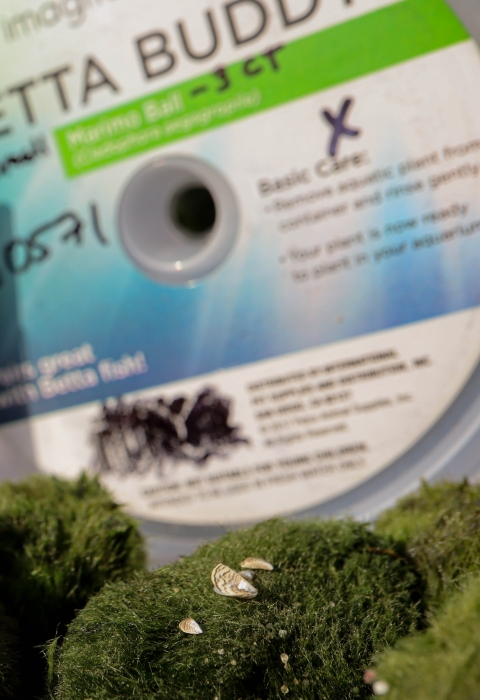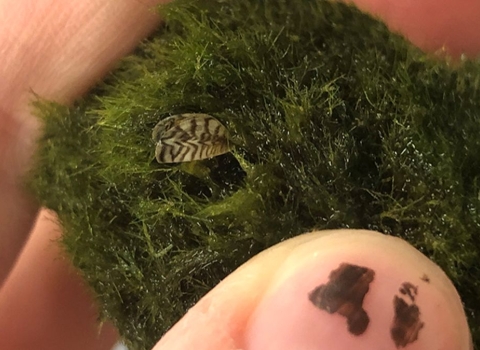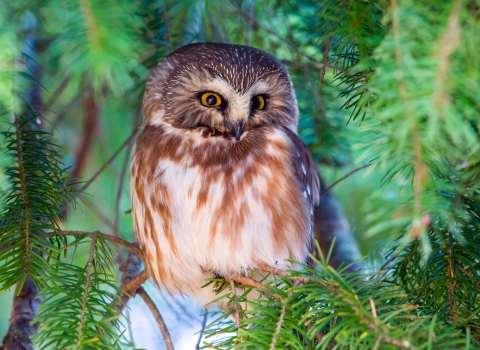Looking for office décor? Do you have fish in need of somewhere to hide? How about a new fuzzy, low maintenance friend to welcome into your home? Some will say the soft and spongy freshwater moss ball can help you with any of these needs.
But what is a moss ball? Some moss balls are real moss taped to a Styrofoam ball, but others are not actually moss. Instead, they are a filamentous alga sourced primarily from eastern Europe. Moss balls are sold at both online and in-person retailers. They come in a variety of styles and sizes for your aquarium, including Marimo Balls and Shrimp Buddies. You may also see the moss balls sold as a fancy terrarium longing for its place amongst your house plants.
A Kinder Surprise in the Moss Balls
Despite the appeal of a ball of filamentous algae in your home, moss balls can have a serious side-effect. Moss balls can carry zebra mussels — a tiny invasive species invasive species
An invasive species is any plant or animal that has spread or been introduced into a new area where they are, or could, cause harm to the environment, economy, or human, animal, or plant health. Their unwelcome presence can destroy ecosystems and cost millions of dollars.
Learn more about invasive species also from eastern Europe.
Zebra mussels first arrived in the Great Lakes Region of the U.S. through ballast water in the 1980’s. These invaders further spread throughout the states mostly through contaminated boats or outdoor recreation equipment. Alaska was mostly spared from this invasion, until March of 2021 when zebra mussels rode into the state on aquarium moss balls.
You can identify a zebra mussel by the striped pattern on its shell (hence the name “zebra”). Unlike their close cousin, the quagga mussel, zebra mussels remain stable on their flattened underside when placed on a flat surface. A single zebra mussel can grow up to two inches long, but most are less than an inch.
Size doesn’t stop zebra mussels, because they have a variety of nifty features that make them a powerhouse in a tiny shell. A main superpower of zebra mussels is their ability to reproduce. Zebra mussels can multiply up to 100,000 individuals per square meter. In some cases, zebra mussels were found attached in the thousands to a single native mussel. Another super trick of the zebra mussel is that each mussel can filter a liter of water a day, removing zooplankton and phytoplankton from the water they inhabit. This feature means zebra mussels can be a serious competitor for the foods that salmon rely on.
The tacky stripes on their shells? Don’t let them fool you. Zebra mussels have a price tag of $500 million annually in the Great Lakes region of the U.S. This expense is for management efforts and infrastructure maintenance but does not include the impacts to native fisheries and food webs, or even the effects of toxic byproduct from the mussels. Shoreline home values have also decreased in areas with zebra mussels. Alaska’s native mussels likely do not stand a chance and could be outcompeted by zebra mussels, based on what has been seen in the midwest and southeastern US.
If you’re thinking “Zebra mussels sound like they’re the worst”, you would be right. They are considered one of the worst invasive species in the world due to their destructive impacts on wildlife and the economy.
Alaska has been wild and free from zebra mussels, but now, your salmon and native mussels are at risk. Thanks to moss balls, zebra mussels have found their way into the state.
This is B-A-D.
To protect Alaska’s wildlife and waters, zebra mussels are regulated at various levels. Nationally, zebra mussels are identified as an injurious species by the U.S. Fish and Wildlife Service under the Lacey Act. In Alaska, zebra mussels are listed as a quarantine species, which means bringing them into the state is illegal.
You can do your part to protect Alaska’s wildlife and waters by remembering to clean, drain, dry your gear every time between uses. Don’t dump your tank if you are an aquarium or terrarium owner. Please report moss ball purchases, zebra mussels, or other unexpected critters in moss balls or elsewhere to 1–877-INVASIV. You can also use the ADF&G Online Reporter.
In the meantime, keep all components inside the tank until cleaned using guidelines on the USFWS “Invasive Zebra Mussels Found in Moss Balls” page (see below). By following these steps, you are helping keep Alaska wild and free of invasive species.











